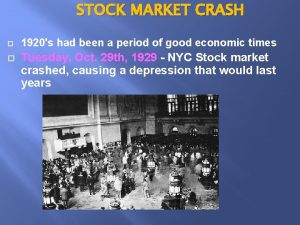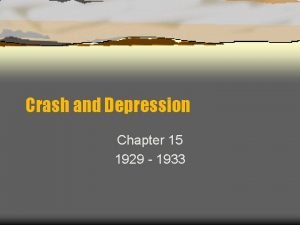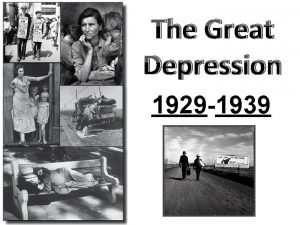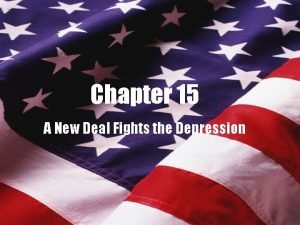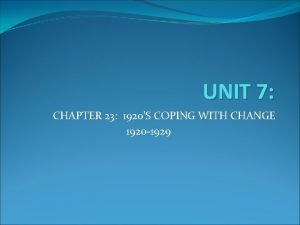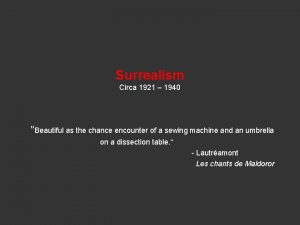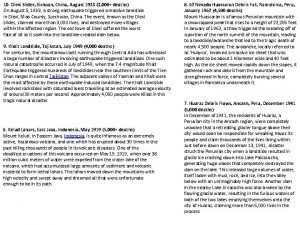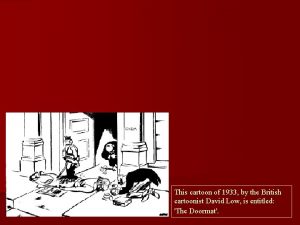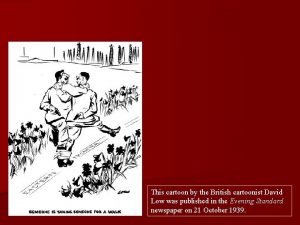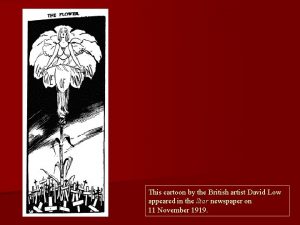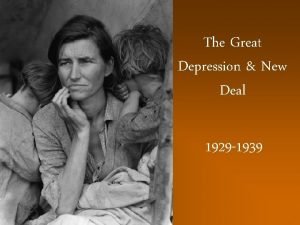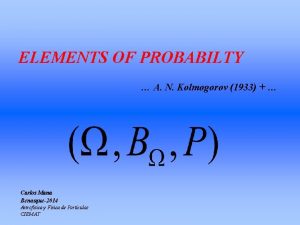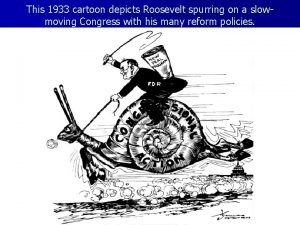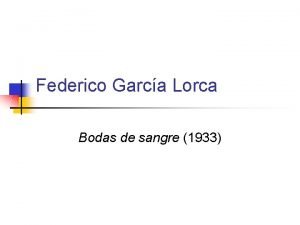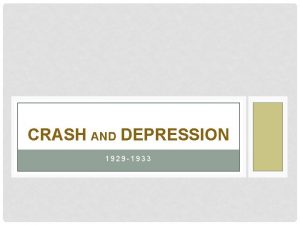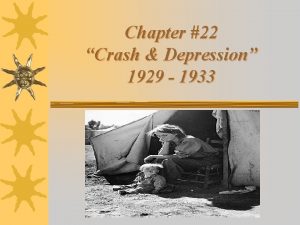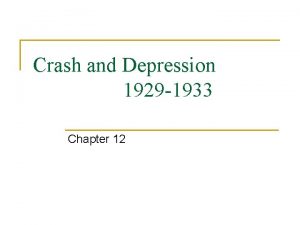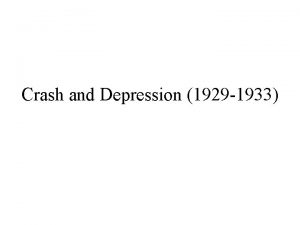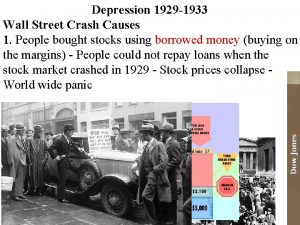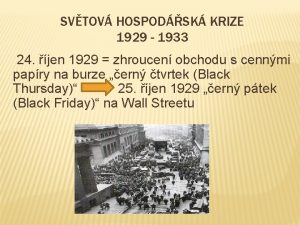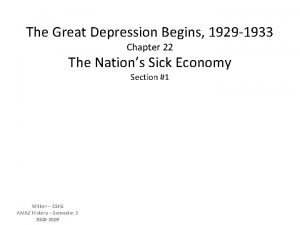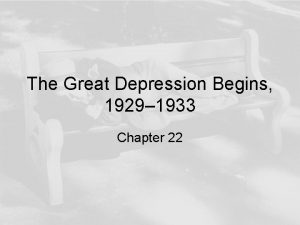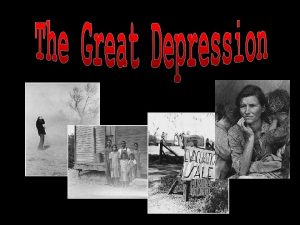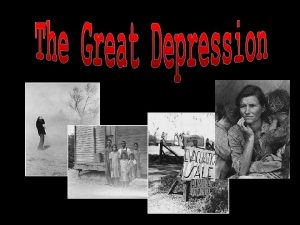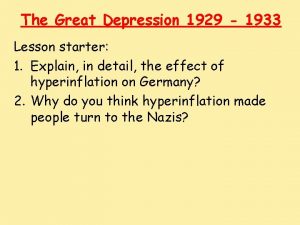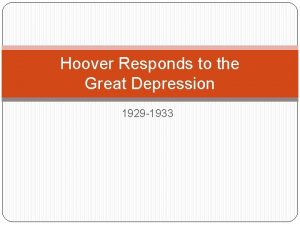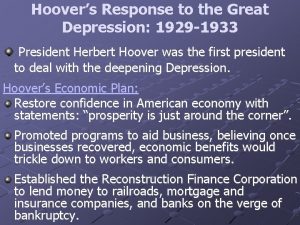Chapter 22 Crash Depression 1929 1933 Section 1






















- Slides: 22

Chapter #22 “Crash & Depression” 1929 - 1933

Section #1 “The Economy in the Late 1920’s” ¬ Healthy Economy? – 1925: Stock market $27 Billion – 1928: stock values rose $11. 4 billion. The year was described as “of unprecedented advance, of wonderful prosperity. ” – New York Times – Oct. 1929: stock values hit $87 Billion. – Since 1914 workers wages 40%. – Unemployment under 4%. – Best selling book: “The Man Nobody Knows (1925) – Bruce Barton – 1929 article by John J. Raskob – “Everybody Ought to Be Rich” – welfare capitalism: An approach to labor relations in which companies met some of their workers’ needs without prompting by unions.

Uneven Prosperity ¬ The Rich get richer! • Huge corporations • 200 large companies controlled 49% of American industry. • 24, 000 families (0. 1%) had incomes of more than $100, 000 & held more than 34% of the country’s total savings. ¬ The Poor get poorer! • 71% of individuals and families earned less than $2, 500. • 80% of families had no savings. • Everyone in the family, including children, had to work to get by.

Other Economic Dangers ¬ Buying on Credit – Increased personal debt. – Installment plans made expensive items irresistible. ¬ Stock Market – speculation: the practice of marking high-risk investments in hopes of getting a high gain. – buying on margin: purchase a stock for only a fraction of its price and borrow the rest. – Brokers charged high interest rates and could demand payment or loan at any time. ¬ Supply & Demand – Warehouses full of unbought goods. – Automobile industry. – Housing construction fell 25% from 1928 – 1929. ¬ Farmers – Prices for farm products plummeted after the wartime demand ended. (wheat & cotton) – Farmers bought more land. ¬ Workers – Most laborers did not benefit from prosperity of big business. – 56 hour work week for 16 to 18 cents an hour = $10 a week.

Section #2: “The Stock Market Crash” ¬ Dow Jones Industrial Average: an average of stock prices of major industries. – Early 1928 = 191. – Hoover’s inauguration day, March 4, 1929 = 313. – September 3 rd, all time high at 381. ¬ The Market Crashes – Black Thursday: October 24, 1929, worried investors began to sell and stock prices fell. (ex. GE $400 down to $283) – Black Tuesday: October 29, 16. 4 million shares were sold. – By Nov. 13, 1929, the Dow Jones had fallen from 381 to 198. 7 = losses totaling $30 billion. Known as the Great Crash. – business cycle: the periodic growth and contraction of a nation’s economy. See page #636.

Stock market crash *In billions of dollars. Based on Standard and Poor’s index of common stocks. Source: Historical Statistics of the United States, Colonial Times to 1970.

Effects of the Crash ¬ Great Depression: a severe economic decline that lasted from 1929 until the United States’ entry into World War II in 1941. – Millions of Americans lost their jobs, homes, and farms. – 1931 Henry Ford closed down his Detroit plants, 75, 000 unemployed. – Gross National Product (GNP): the total value of goods and services a country produces annually. • $103 billion in 1929. • By 1933 it was only $56 billion. • Bushel of wheat went from $1. 04 in 1929 to 38 cents in 1932. • Banks close – 5, 000 banks closed. – By 1933, 9 million savings accounts vanished.

Impact on the World ¬ When the world’s leading economy fell, the global economic system began to crumble. – U. S. insisted that Britain and France repay war debts. – Congress kept wartime tariffs high. – Allies had to rely on Germany’s reparations payments for income. • German banks failed when U. S. companies investments failed. – Europeans could no longer afford to buy American made goods. – American stock market crash caused a downward cycle in the global economy.

Causes & Effects of the Great Depression CAUSES *The 1920’s economy is out of balance. *Americans are increasingly in debt. *Speculation is on the rise. *Overproduction slows industrial growth. *The federal government introduces a tight money policy in order to control credit. *The stock market crashes in October 1929. THE GREAT DEPRESSION Effects *Millions of workers lose their jobs. *Gross National Product falls dramatically. *Many banks fail. *Increased poverty leads to health and social programs. *Global economy suffers.

Section #3 Social Effects – Great Depression ¬ Immediate impact did not hit all – 1931 -32 all were effected. ¬ Professional, white collar, blue collar-ALL lost jobs, savings accounts, & homes. Poverty did not discriminate. ¬ “Hooverville” ¬ What environmental condition compounded the Great Depression?

Hoovervilles

Hoovervilles

Section 3 - continued ¬ The Grapes of Wrath – John Steinbeck ¬ What was the Dust Bowl?

Anxiety, Suicide, Family Stress ¬ Competition for scarce resources especially jobs, caused an increase in discrimination ¬ 56% of Blacks were unemployed in 1932 ¬ Less divorces… why? ¬ Suicide way up… why?

Section 4 - Surviving the Great Depression ¬ Determination and humor ¬ They helped one another, looked for solutions, and worked to identify the problems within our social, political, and economic systems. ¬ However, some people (blacks, immigrants, Jews) were still discriminated against – Ex. Scottsboro Boys Case ¬ The Communist and Socialist Parties offered solutions to the problems of capitalism and democracy.

Signs of Change sec. 4 cont. ¬ 1933, during the heart of the Depression, Prohibition was ended with the 21 st Amendment. ¬ Empire State Building construction started in 1930. Why was it considered a symbol of hope?

The Election of 1932 – F. D. R ¬ Hoover’s response to the Depression – “worldwide economic conditions beyond our control” ¬ Voluntary action by businesses to keep wages up was Hoover’s “fix-it” plan; businesses did not continue to voluntarily help ¬ Gov’t stimulated the Depression economy with public works projects (i. e. Hoover Dam)

Hoover Dam!

Hoover Dam – Completed in 1936

Hoover’s demise. . . From ‘Great Humanitarian’ to cold & hard-hearted! ¬ Hoover’s RFC – gave gov’t credit to banks to extend loans – Trickle down theory of economics made the gov’t look like they were helping bankers and not ordinary people. (Reconstruction Finance Corporation – banks still failed) ¬ Hawley-Smoot tariff – the highest in history, backfired. Europe raised their tariffs – stifled trade. ¬ Propaganda efforts against Hoover aided in his political downfall, in addition to economic conditions not improving.

The Bonus Army – sec 5 cont. ¬ 1932 – 20, 000 WWI veterans march on D. C. demanding their pensions payments. ¬ The H. O. R. agreed to pay, the Senate did not. ¬ President Hoover called in General Mac. Arthur to drive the marchers out of D. C. – he turned the military against those who fought to defend freedom during WWI.

The New Deal & F. D. R (D) “Happy Days are here again!” ¬ Map on pg. 652 – Landslide for FDR/Eleanor – 7 million popular votes ¬ More voted against Hoover ¬ Many minorities favored FDR
 Stock market crash 1929 cartoon
Stock market crash 1929 cartoon Stock market crash in 1929
Stock market crash in 1929 Stock market crash 1942
Stock market crash 1942 Fun facts about the stock market crash of 1929
Fun facts about the stock market crash of 1929 During the great depression there were many wanderers
During the great depression there were many wanderers Chapter 15 crash and depression
Chapter 15 crash and depression Rrr great depression
Rrr great depression Hoover struggles with depression
Hoover struggles with depression Chapter 15 section 1 a new deal fights the depression
Chapter 15 section 1 a new deal fights the depression Chapter 23 activity: coping with change, 1920-1929
Chapter 23 activity: coping with change, 1920-1929 Un chien andalusia
Un chien andalusia Merdiven şiiri tahlili
Merdiven şiiri tahlili Diexi slides, sichuan, china, august 1933
Diexi slides, sichuan, china, august 1933 Cartoon 1933
Cartoon 1933 David low cartoon in the london evening standard march 1948
David low cartoon in the london evening standard march 1948 David low cartoons league of nations
David low cartoons league of nations National industrial recovery act of 1933
National industrial recovery act of 1933 Congresso ciam
Congresso ciam Kolmogorov 1933
Kolmogorov 1933 Feruza bobokulova
Feruza bobokulova Ernst rohm cartoon
Ernst rohm cartoon Cartoon 1933
Cartoon 1933 Bodas de sangre 1933
Bodas de sangre 1933



